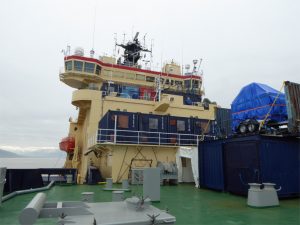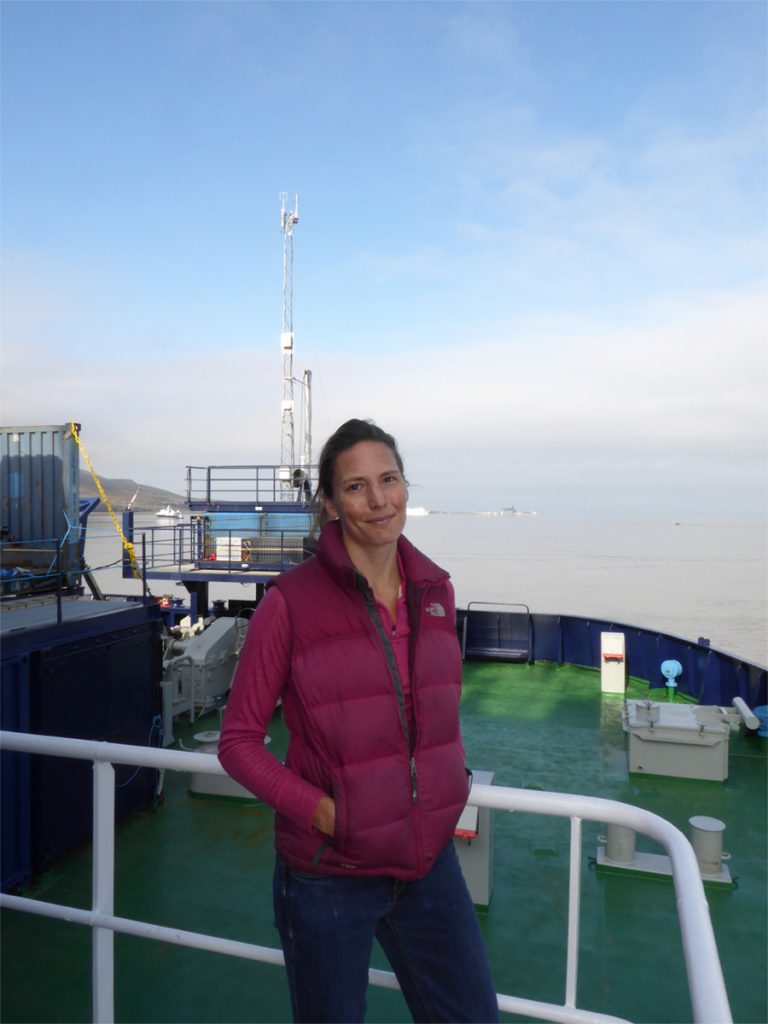For Now, The Ship is Still
Blog in a Teacup by Dr Helen Czerski I’m sitting on the bridge, the highest place on the ship that’s still indoors. The bridge is reminiscent of the head of a hammerhead shark: it’s a long room on the 6th deck, oriented across the ship with two extra protrusions at the ends which stick out over the ship sides. There are large glass windows all the way around, so the captain can see everything going on around his (it is a him, in this case) ship at all times. The meteorologist sits up here, and the data from radio, radar, sonar and satellites comes here first. This is the nerve centre of the ship, the point where human and machine inputs are used together to make decisions.
I’m sitting on the bridge, the highest place on the ship that’s still indoors. The bridge is reminiscent of the head of a hammerhead shark: it’s a long room on the 6th deck, oriented across the ship with two extra protrusions at the ends which stick out over the ship sides. There are large glass windows all the way around, so the captain can see everything going on around his (it is a him, in this case) ship at all times. The meteorologist sits up here, and the data from radio, radar, sonar and satellites comes here first. This is the nerve centre of the ship, the point where human and machine inputs are used together to make decisions.
As I write this, the bridge is quiet. We’re moored in the middle of a fjord just off the tiny town of Longyearbyen, and the ship’s engines are switched off. At 3pm today, a pilot will arrive to guide the ship out of the fjord and then we will be on our way. But for now, the ship is still.
Squirrelled away on board there are 74 humans, although it’s hard to believe that. All ships are compartmentalised by design, and windows are obviously in short supply. People can be tucked away in all sorts of corners. The Oden is an icebreaker, not a dedicated research ship, so there’s no lab space indoors. Instead, the decks are stacked high with shipping containers, and a high proportion of those containers have labs and scientists inside. The consequence is that the ship feels mostly empty  except at mealtimes. Finding people can be a problem. The solution? A phone. Yesterday each of us was issued with a special ship mobile phone, a bit like an old-school Nokia, that can call everyone on the ship but no-one outside. You might think that one of the best bits about being in the High Arctic would be freedom from phones, but we’ve all been told very sternly that we need to be contactable at all times. For the next 8 weeks, my little grey phone will be a constant presence in my life. I understand why, but I can’t honestly say that I’m overwhelmed with joy at this prospect. Apparently even the North Pole isn’t far enough to get away from some aspects of the modern world.
except at mealtimes. Finding people can be a problem. The solution? A phone. Yesterday each of us was issued with a special ship mobile phone, a bit like an old-school Nokia, that can call everyone on the ship but no-one outside. You might think that one of the best bits about being in the High Arctic would be freedom from phones, but we’ve all been told very sternly that we need to be contactable at all times. For the next 8 weeks, my little grey phone will be a constant presence in my life. I understand why, but I can’t honestly say that I’m overwhelmed with joy at this prospect. Apparently even the North Pole isn’t far enough to get away from some aspects of the modern world.
The reason that I’m up on the bridge is that I haven’t got much else to do. It’s slightly frustrating, because everyone else is running around setting up experiments. But my science cases won’t be unpacked until we’re in the sea ice, because if it gets bumpy on the transit to the ice edge, I’ll only have to pack it up again. My work will be entirely out on the ice, but the ship is festooned with atmospheric science sensors, some of them deliciously Wallace and Gromit in appearance. That’s what everyone else is busy with. It feels a bit like cheating not to be joining in, but the hard work is coming soon enough.
 I’ve never been on a ship-based expedition with this many other scientists before – there are around 40 on this ship. Every single berth is taken, with most of us sharing cabins that each have two rooms, one bathroom and four bunks. There is no private space anywhere on the ship, apart from possibly the bathrooms. I wanted to make sure that I had an alarm that would wake me but not my roommates, so before coming here I bought a wrist activity tracker which also has a silent alarm. I left it on yesterday to use it as a watch, and at the end of the day it announced that I had taken 12,224 steps. I was surprised it was that high, but to get anywhere on the ship you have to go down and round and up and across, navigating the lumpy superstructure and its cargo of shipping containers. That’s a good sign – I’m a fidget and even when I’m not in the ship’s gym, I’ll clearly be getting a reasonable amount of exercise.
I’ve never been on a ship-based expedition with this many other scientists before – there are around 40 on this ship. Every single berth is taken, with most of us sharing cabins that each have two rooms, one bathroom and four bunks. There is no private space anywhere on the ship, apart from possibly the bathrooms. I wanted to make sure that I had an alarm that would wake me but not my roommates, so before coming here I bought a wrist activity tracker which also has a silent alarm. I left it on yesterday to use it as a watch, and at the end of the day it announced that I had taken 12,224 steps. I was surprised it was that high, but to get anywhere on the ship you have to go down and round and up and across, navigating the lumpy superstructure and its cargo of shipping containers. That’s a good sign – I’m a fidget and even when I’m not in the ship’s gym, I’ll clearly be getting a reasonable amount of exercise.
So here we are, almost ready to go. If all goes to plan, I won’t step on solid land for another eight weeks, and I won’t see a sunset for another five weeks. It will take 36 hours to reach the ice edge, followed by a 24 hour stop to test all the equipment, and then we will travel north for another week, until pointing north becomes pointing south and maybe a bit beyond. But for now, up here on the bridge, it’s quiet. For the next five hours, we wait.
 Dr Helen Czerski is a physicist, first and foremost, but she’s acquired a few other labels along the way: oceanographer, presenter, author and bubble enthusiast. A regular on The Cosmic Shambles Network, she has also presented a number of acclaimed documentaries for the BBC and her first book, Storm in a Teacup, which looked at the physics of every day things, was a bestseller. Recently she was awarded the prestigious William Thomson, Lord Kelvin Medal and Prize from the Institute of Physics.
Dr Helen Czerski is a physicist, first and foremost, but she’s acquired a few other labels along the way: oceanographer, presenter, author and bubble enthusiast. A regular on The Cosmic Shambles Network, she has also presented a number of acclaimed documentaries for the BBC and her first book, Storm in a Teacup, which looked at the physics of every day things, was a bestseller. Recently she was awarded the prestigious William Thomson, Lord Kelvin Medal and Prize from the Institute of Physics.


